Social Media in 2024: What Marketers Should Know
23/02/24
7'
What does the future hold for social media in 2024, and what are the key developments and statistics that marketers need to be aware of? We’ve analyzed three recent reports, providing us with insightful perspectives and data. Discover the results.
State of Social Media in 2024
Which social platforms are popular, which less?
In assessing the landscape of popular social media platforms, it’s important to differentiate between individual preferences and business usage trends. The Digital 2024 Global Overview Report shows us that among global users aged 16 to 64, Instagram emerges as the most favored platform, garnering 16.5% of preferences. Facebook, sharing the third spot with WeChat, commands a 12.8% preference rate. TikTok, although trailing with a preference rate of 7.4%, reveals a different story when we consider user engagement metrics. From July to September 2023, data from Android app usage indicates that TikTok users lead in average time spent on the platform, clocking in at an impressive 34 hours monthly. YouTube users average 19 hours and 47 minutes monthly, while Facebook users spend about 28 hours and 5 minutes.
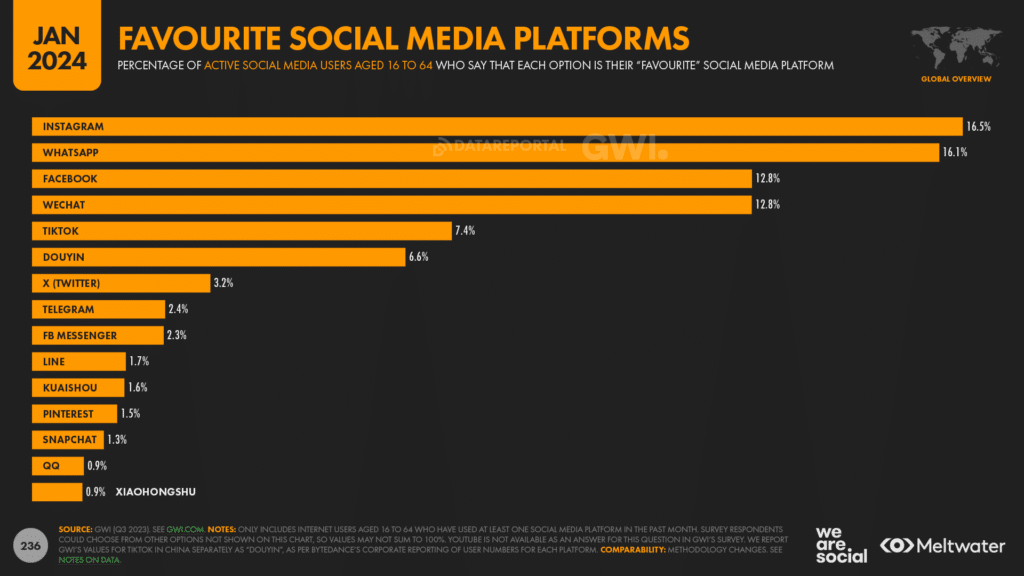
Shifting focus to the business and organizational sphere, the dynamics differ. In 2023, a significant majority of organizations maintain a social media presence, with Facebook leading at 91%, followed by Instagram (86%) and LinkedIn (80%). Noteworthy trends in platform adoption for business use include TikTok, experiencing a 16% increase in usage, and LinkedIn with a 5% rise. Conversely, X (formerly known as Twitter) and Pinterest have seen declines in business use by 7% and 11%, respectively (source: Social Trends 2024 Report from Hootsuite).
These shifts underscore the evolving nature of social media as a tool for both personal connection and business engagement.
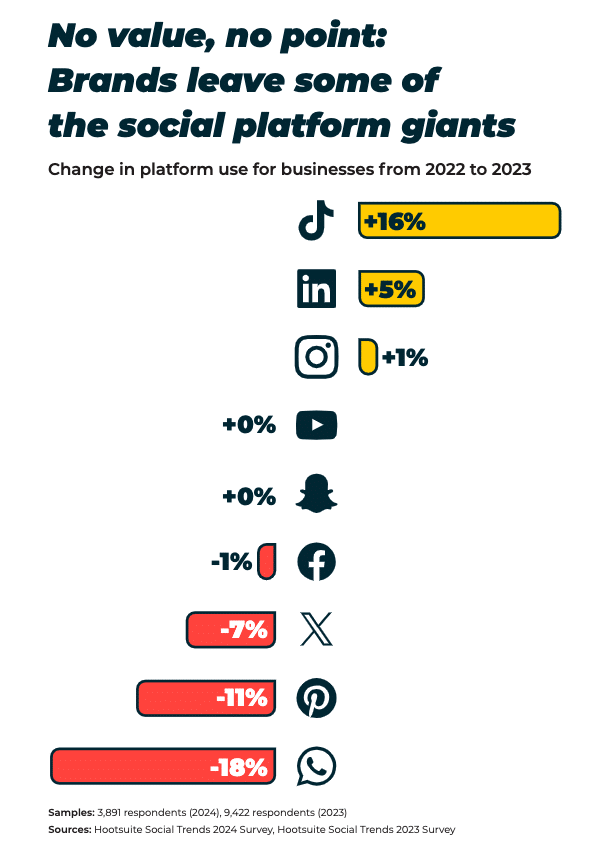
What about shopping on social media?
The Digital 2024 Global Overview Report also offers insightful revelations about social media’s role in e-commerce. A predominant 50% of social media users engage with these platforms primarily to stay connected with friends and family (no surprise!). However, a substantial 26.7% use social media for discovering new activities and items to buy, while 26.1% actively seek products to purchase. These figures firmly establish social media as a legitimate and influential channel for e-commerce sales. This is further emphasized when compared to broader internet user behavior, where 74.3% of users aged 16 to 64 frequent shopping, auction, or classified websites and apps, and 43.7% use the internet predominantly for researching products and brands.
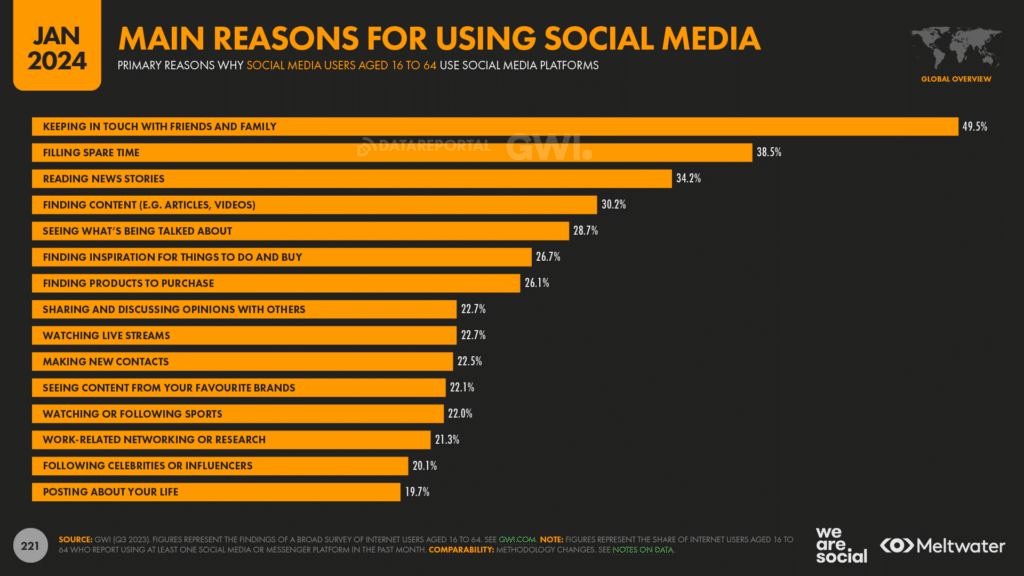
Diving deeper into the nuances of social media and e-commerce, there’s a variation in how consumers use different channels for product discovery and purchase. Social media emerges as the dominant channel, with 50% of respondents utilizing it for discovering products. Influencers also play a significant role, influencing 22% of respondents in product discovery. In terms of actual purchasing, social media leads once again with a 59% usage rate, while messaging apps are utilized by 36% of respondents for purchases (source: Insider Intelligence / eMarketer).
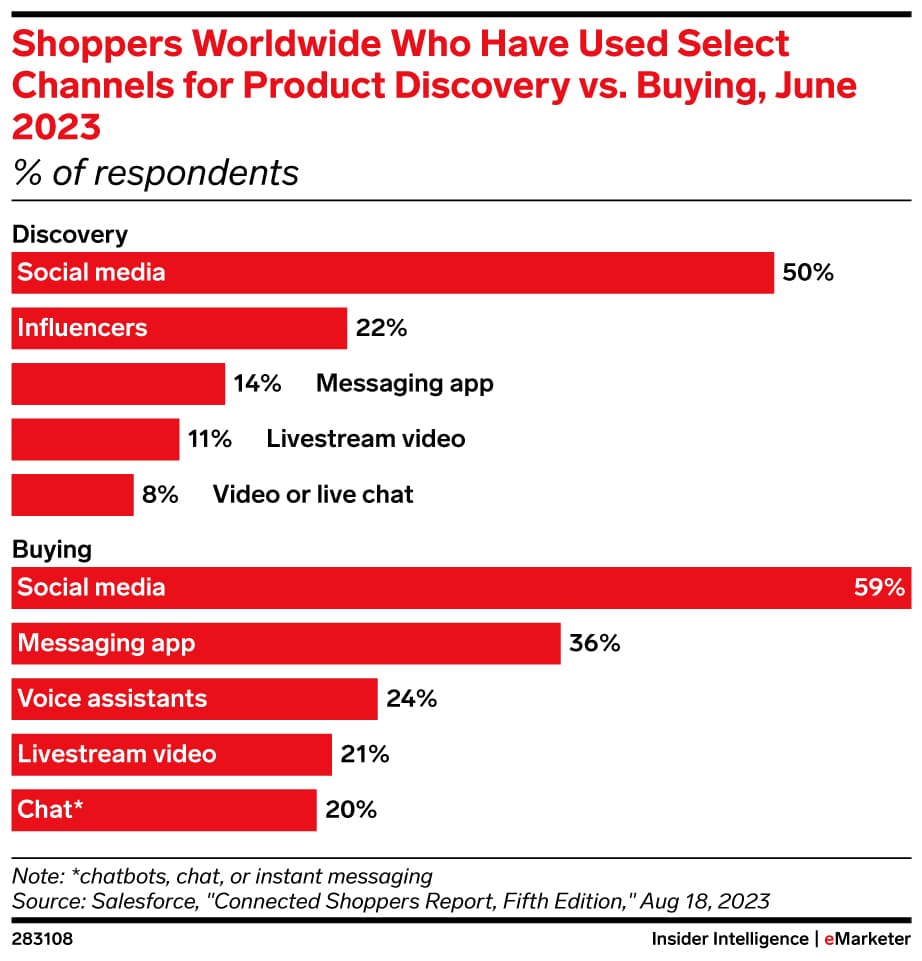
Focusing on the U.S. market, a stark contrast emerges between the general adult population and Gen Z (ages 18-26) in terms of making direct purchases on social networks. Instagram is a prime example, with 71% of Gen Z users likely to make purchases directly through the platform, compared to just 40% of the broader U.S. adult population. YouTube shows a similar trend, with 68% of Gen Z likely to make direct purchases, a figure significantly higher than the 46% observed in the total population. TikTok mirrors this popularity among Gen Z, with a 68% likelihood of direct purchases, in contrast to 39% among the total U.S. adult population. Snapchat also exhibits notable generational differences, with 55% of Gen Z respondents inclined to make direct purchases, compared to 31% of the overall population.
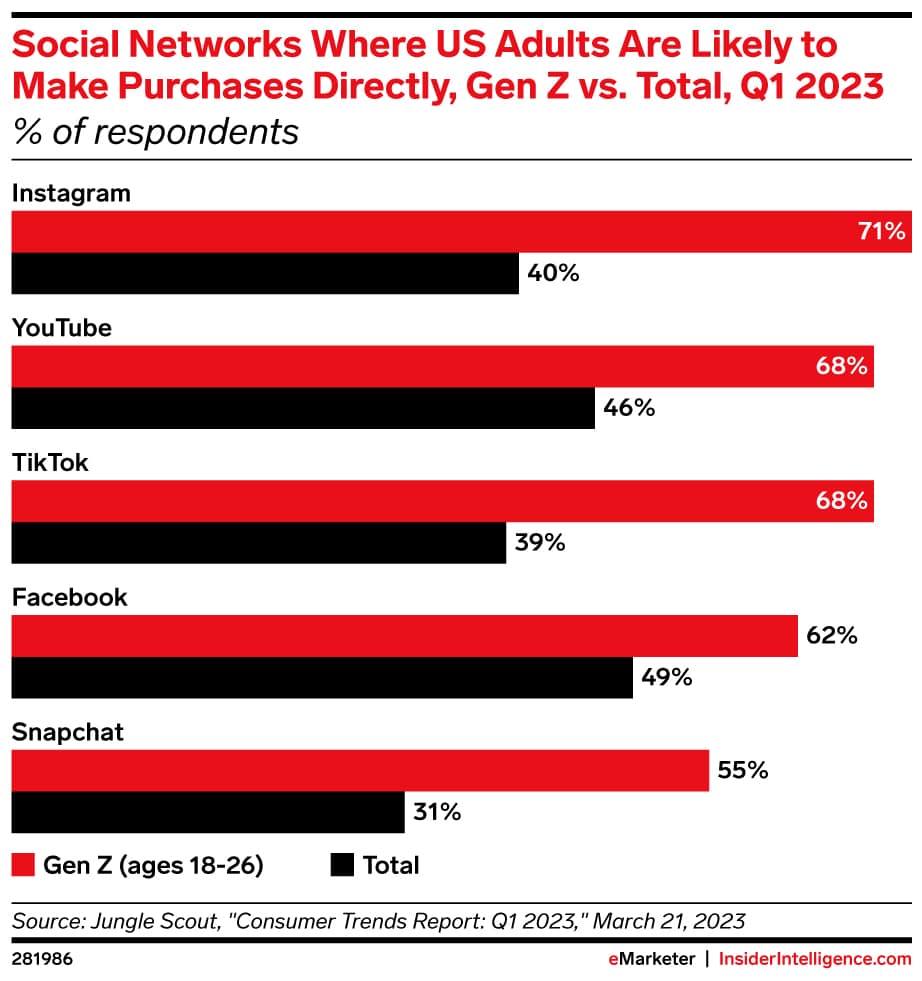
These statistics underscore a pivotal trend: Gen Z’s preference for direct purchases on social platforms significantly outpaces that of the broader U.S. adult population, highlighting the growing influence of these networks in the purchasing decisions of younger consumers.
Social Media Trends for Marketers
AI’s role in revolutionizing advertising strategies stands out as a pivotal trend (no doubt!). AI-driven tools enable more sophisticated targeting and personalization by analyzing detailed data, thus ensuring ads are highly relevant to specific user groups. This technology enhances ad creatives through methods like A/B testing to determine the most effective combinations. Real-time bidding algorithms optimize the timing and audience relevance of ad placements, maximizing conversion potential. Additionally, predictive analysis refines content recommendations, including sponsored posts, aligning them more closely with user interests.
However, it’s crucial not to be solely fixated on AI. Other emerging trends and strategies in social media marketing for 2024 warrant attention:
Integrating User-Generated Content (UGC) into Ads
User-generated content is increasingly recognized for its authenticity and trust-building capacity. A Deloitte survey from November 2022 revealed that 46% of U.S. consumers are more likely to trust a brand reviewed by an online content creator they trust. Leveraging UGC, which can include reviews, images, and videos created by users, not only fosters community engagement but also bolsters brand credibility. Lengow simplifies the integration of UGC into your product catalog, streamlining the process of incorporating authentic customer experiences into Dynamic Product Ads.
Try interactive Ads
In a landscape saturated with advertisements, it’s crucial to stand out. Interactive ads offer an immersive experience that engages users in a novel way. Facebook’s Instant Experiences, for instance, are full-screen ads that allow users to interact with and personalize their viewing experience. Interactive ads can significantly enhance user engagement and brand interaction, making them a noteworthy trend in social media marketing.
To capitalize on this trend, experiment with interactive ad formats like Facebook Instant Experience ads. These provide a dynamic, engaging way for audiences to connect with your brand.
Dynamic Creative Optimization (DCO)
DCO represents a sophisticated approach in programmatic advertising, creating personalized ads based on viewer-specific data at the moment of ad serving. It utilizes algorithms and real-time data to automatically generate ad creatives tailored to the user’s demographics, interests, and online behavior. This level of customization ensures that ads are not only relevant but also effective in engaging each individual user, enhancing overall engagement, relevance, and conversion rates.
Embrace TikTok for Dynamic Advertising (if not done yet)
A crucial trend for modern marketers is harnessing the power of TikTok’s Dynamic Showcase Ads (DSA) and Dynamic Product Ads. This approach is particularly beneficial for companies looking to advertise a large range of products efficiently. The challenge of creating ads for thousands of products can seem overwhelming, but automation is a practical solution.
For instance, the fast-fashion brand Pimkie, using Lengow’s platform, showcased over 2,000 products on TikTok in just 15 days. This rapid implementation, a first for a French brand on TikTok, yielded impressive results:
- Over 1 million user coverage.
- 78% of impressions targeted users under 25 years old.
- A significant increase (+10 points) in new customer acquisition rate via the website post-campaign launch.
This example highlights the effectiveness of TikTok’s advertising tools, especially when integrated with platforms like Lengow, for reaching a young and dynamic audience and achieving notable marketing success.
Your e-commerce library
E-commerce for Retailers
Learn moreE-commerce for Brands
Learn moreL'Oréal Luxe Success Story
Learn moreSign up for our newsletter
By submitting this form you authorize Lengow to process your data for the purpose of sending you Lengow newsletters . You have the right to access, rectify and delete this data, to oppose its processing, to limit its use, to render it portable and to define the guidelines relating to its fate in the event of death. You can exercise these rights at any time by writing to dpo@lengow.com

Trending Posts
Marketing channels
Where does Gen Z shop online?
Gen Z online shopping is transforming the digital marketplace, setting trends that redefine what it means to engage with brands…
16/04/24
9'
Marketplaces
The Top 10 Marketplaces in Europe
The e-commerce scene is a vibrant mix of marketplaces in Europe. These aren't just websites; they're bustling hubs where millions…
08/12/23
7'
Marketplaces
Lengow Now Fully Supports Zalando Logistics Solutions ZSS and ZRS
Zalando, one of Europe’s leading fashion marketplaces, continues to raise the bar with its advanced logistics and fulfillment programs. After…
12/12/24
4'
Marketplaces
How to win the Buy Box on Marketplaces (Amazon, Zalando, etc.)
What is the most important thing for marketplace sellers? Exactly, the Buy Box! If you don't have the Buy Box…
02/04/24
10'
Marketplaces
How to Sell on Temu? Best Tips
Emerging under the vast umbrella of PDD Holdings Inc., Temu has skyrocketed in popularity as a shopping sensation from China…
17/08/23
5'




